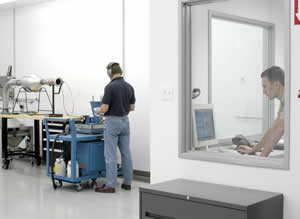We use cookies to make your experience better. To comply with the new e-Privacy directive, we need to ask for your consent to set the cookies. Learn more.
K&N Air Filter Efficiency Testing

The air filter industry uses the ISO 5011 testing protocol when testing filtration efficiency and dust capacity. The test protocol calls for the introduction of a measured amount of "test dust" into the air filter at a selected airflow rate. The test is then terminated after the filter reaches a selected level of restriction (terminal test pressure). The test protocol then measures the percentage of dust retained by the filter (efficiency) and the total amount of dust held by the filter (capacity).
The ISO 5011 protocol allows for flexibility in test design and choice in the variables selected for the test. This means that you can change the grade of test dust, the airflow rate, the beginning and end points of the test, and other factors while still being in conformity with the protocol. For example, the filter can be tested in a special “test housing” or in the factory air box. As you can see, the ISO 5011 test protocol it is not an absolute test or standard; it is meant to help engineers design air filters by holding conditions constant while one variable is changed to measure the change impact.
If all the variables are consistent between two tests, the results can be used to compare the filtration capabilities of two air filters in a laboratory setting under specific controlled conditions. However, any filtration measurement will only be meaningful if it includes disclosure of the test variables that were selected, such as grade of test dust, airflow rate and terminal test pressure.
Because the ISO 5011 protocol uses fixed airflow and is often conducted with the air filter in "test housing," it is not intended to develop a filtration number you will experience in actual use. While in a vehicle, an air filter will experience a range of operating conditions, airflow and dust feed rates, etc.
Under the parameters of the ISO test, the user may select the grade of test dust used. The content of the two most commonly used types of ISO test dust for air filters are as follows:
| ISO COARSE TEST DUST | ISO FINE TEST DUST | ||
Particle Size |
Percent by Volume |
Particle Size |
Percent by Volume |
001 – 005 |
10.5% |
01 – 05 |
36.0% |
005 – 010 |
11.5% |
05 – 10 |
18.0% |
010 – 020 |
14.0% |
10 – 20 |
20.0% |
020 – 040 |
25.0% |
20 – 40 |
17.0% |
040 – 120 |
37.0% |
40 – 120 |
09.0% |
120 – 180 |
02.0% |
|
|
K&N operates an in-house filtration test lab with two different testing machines built in consultation with Southwest Research Institute, one of the pre-eminent testing companies in the world. Most of the filtration testing we perform on our air filters is performed in our lab that operates on a year round basis. Occasionally, we send air filters out for testing with an independent lab, either to confirm our in-house testing or to reduce the capacity requirements on our lab.
We perform tests of filters both in the factory air box and in SAE/ISO recommended test housing fixtures. Our goal is to design filters with the maximum possible airflow achievable while providing guaranteed engine protection.
Our actual air filters when tested generally demonstrate a cumulative filtration efficiency of between 96% and 99%. All this testing we do allows us to guarantee our air filters provide all the protection your vehicle will ever need.
For a more technical explanation of our filtration test stand procedures see our Efficiency Testing Procedure.





